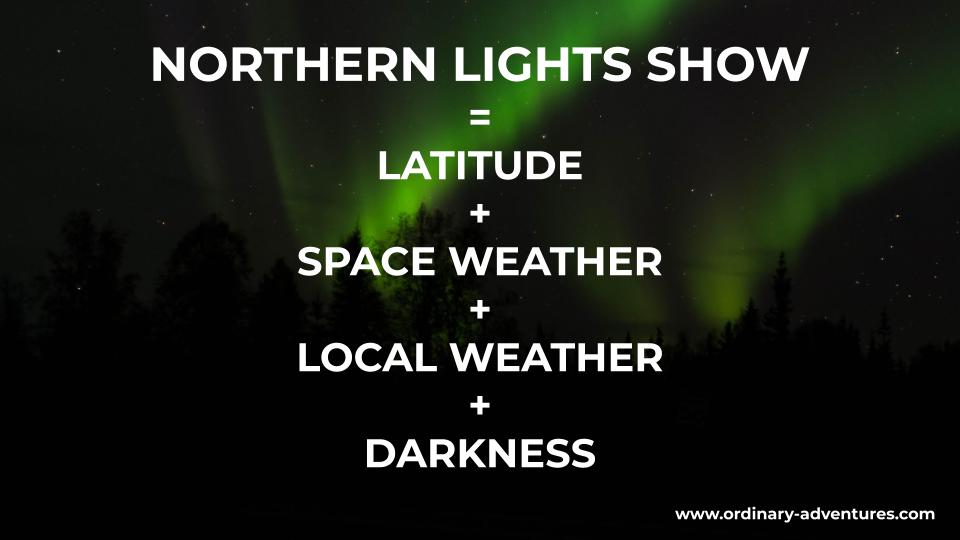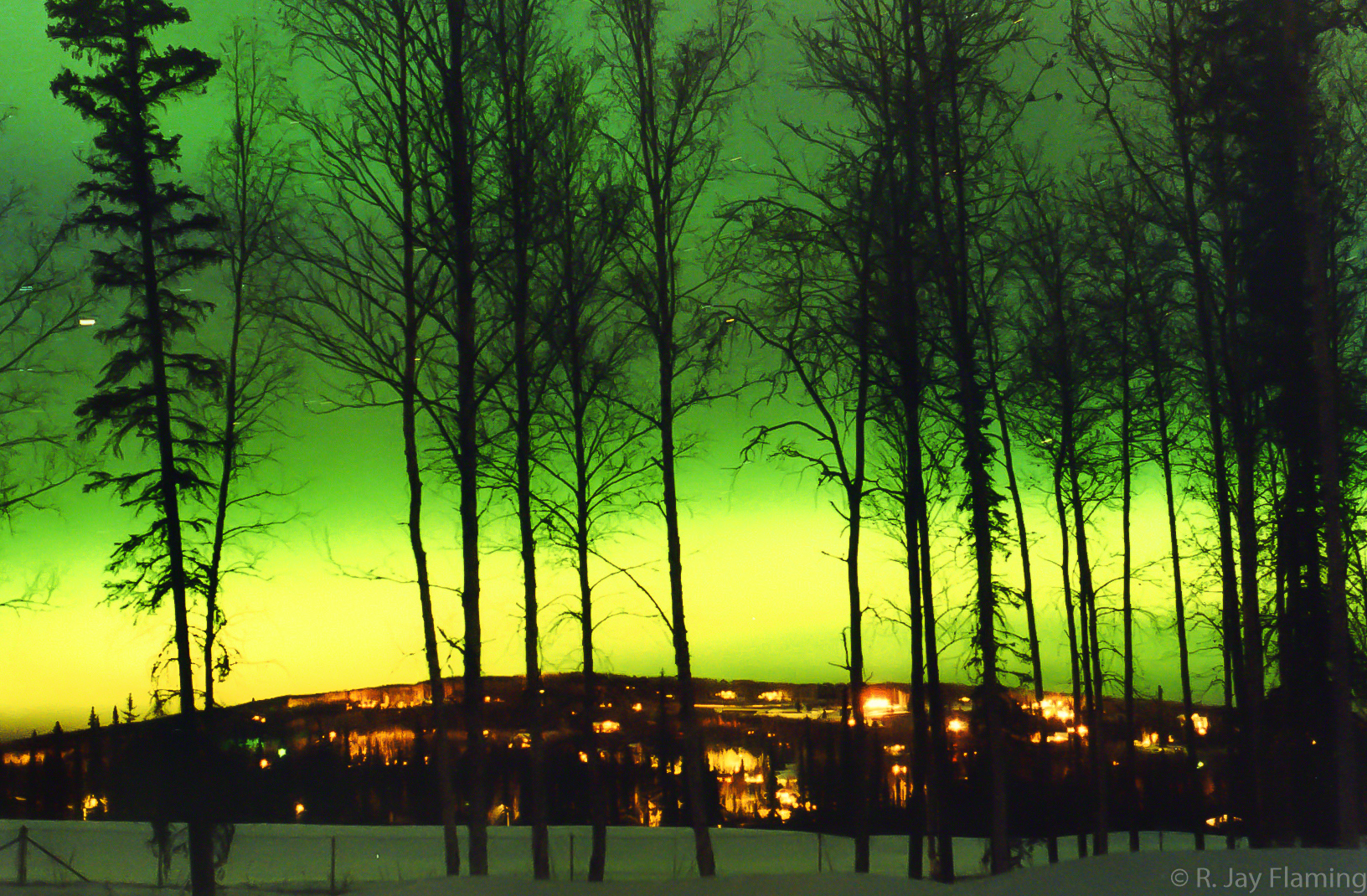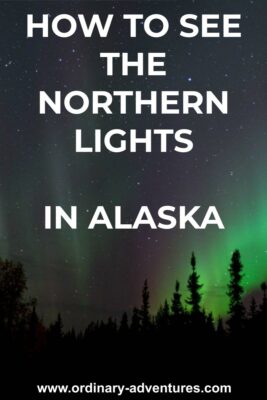How to See the Northern Lights in Fairbanks Alaska
Last Updated on January 7, 2025
Seeing the Northern Lights is a life long dream for so many people and I’m going to share everything you need to know to see the Northern Lights in Fairbanks, Alaska, the best place in the world to see them.
I was lucky enough to live in Fairbanks, Alaska for four years, one of the best places to see the Northern Lights in the world. During that time I got to experience them routinely and my sense of awe only increased, I never took it for granted. I don’t know anyone who has lived in Alaska for a lifetime whose appreciation for the lights ever diminished. I still visit Fairbanks regularly so I also know how to best see them as a visitor.

This article will talk about what the northern lights are, why Fairbanks is the best place to see them, how to improve your chances of seeing them and what to wear to stay warm. My husband, Jay Flaming, a twelve year resident of Fairbanks and experienced photographer, collaborated with me on this article and provided the photography tips. Read on to learn how to plan your own quest to see the Northern Lights in Fairbanks, Alaska!
- What are the Northern Lights?
- Why is Fairbanks, Alaska the best place to see the Northern Lights?
- When is the best time of year to see the Northern Lights?
- How to improve your chances of seeing the Northern Lights
- What to wear to stay warm
- Photography tips

Photo credit: Jay Flaming
What are the Northern Lights?
Before going any farther, it’s important to know what we are even talking about when talking about the Northern Lights! The Northern Lights are technically called the Aurora Borealis and in Alaska they are generally referred to as the “Aurora” or “the lights”. The magical colors we see flashing and rolling across the sky are caused by the interaction of the gases in the earth’s atmosphere protecting us from the solar wind, harmful radiation that is constantly flying at the earth across the solar system. When the gases in our atmosphere get charged up by this radiation they start to glow, which causes the northern lights. Why does this happen in Alaska and other parts of the north (and south), you might be wondering?
The answer has to do with the earth’s magnetic field, which protects us by deflecting the solar wind around the earth. If you remember bar magnets from elementary school, the iron filings get caught up in a loop around the north and south pole of the magnet, and that’s just what happens with the aurora! There’s a concentration of radiation around the poles called the aurora oval. The aurora oval (not the north pole) is the part of the earth where the northern lights are most often visible. The same thing happens in the southern hemisphere, but there isn’t much land around the southern aurora oval except Antarctica so it’s much harder to get to a place to see them. If you have no idea what I’m talking about with the bar magnets, check out this short and awesome video that visually explains how the northern lights work.
The different colors visible in the Northern Lights are caused by the solar wind interacting with different gases at different altitudes in our atmosphere. The most common color is green, but you can also see red and purple colors in an active display!
Sometimes when there’s a very active Aurora, it can feel like it’s coming down and almost like you can touch it! I know I have instinctively backed away against the side my car or a tree or rock but rest assured that the northern lights are happening at least 50 miles above the earth (at least five times as high as an airplane flies) and up to 200 miles above the earth so it’s not actually going to reach you even though it REALLY feels like it might.
Why is Fairbanks the best place to see the Northern Lights?
In the same way you can not guarantee good weather for your outdoor wedding or great snow conditions on a ski trip, the Northern Lights can never be guaranteed. However, by knowing what it takes to see the Northern Lights, you can improve your chances massively!

It’s true that I’m biased, but this is not just an opinion. Here are nine fact based reasons why Fairbanks is the best place to see the northern lights, not just in Alaska but arguably in the world!
- Fairbanks lies directly beneath the aurora oval in the northern hemisphere, making the LATITUDE optimal for the northern lights overhead. If you’ve seen the lights from the lower 48 states, they were probably hovering low on the horizon. That’s not how it is in Fairbanks, where they look like columns of lights descending from directly above.
- Fairbanks has better LOCAL WEATHER (less clouds) than many other locations near or under the auroral oval (such as Iceland, Scandinavia and Anchorage, Alaska).
- Fairbanks has it’s very own SPACE WEATHER forecast at the University of Alaska Fairbanks, giving you everything you need to know to give yourself the best possible chance of seeing the Aurora
- Fairbanks has DARKNESS (but only in winter)
- You can fly to Fairbanks on a commercial flight non stop from Seattle in 3.5-4 hours
- Fairbanks has year round infrastructure for visitors, including hotels, restaurants, grocery stores, rental cars and activities, it’s a town that doesn’t exist exclusively or mainly for tourism.
- Fairbanks is set up to support your Aurora quest! There are tours available and most hotels provide a wake up call if the northern lights are visible upon request.
- Fairbanks is a fun place to visit! It’s important to have other reasons besides the Northern Lights for your trip, because never know when they’re going to come out and you want to be able to have other adventures while you’re waiting

Photo credit: Jay Flaming
When is the best time of year to see the Northern Lights?
Now you know what the Northern Lights are, what conditions you need to see them and why Fairbanks is the best place to see them. So, when should you plan your trip? I recommend planning your northern lights trip to Fairbanks in March or the end of February because:
- It’s dark at night: September through March it’s dark enough to see the Northern Lights at reasonable hours
- It’s close to the equinox: According to the University of Alaska Fairbanks, the northern lights are out more frequently near the equinox (March 21 and September 21) than they are near the solstice (December 21)
- March statistically has clearer weather than fall
- March is not as cold as December, January and February (though it’s still cold, see below for how to stay warm)
- There are lots of other activities to enjoy in Fairbanks in March, such as cross country skiing (multiple fantastic trail systems), visiting Chena Hot Springs and the ice museum and the world ice art championships! Lots of fun to be had while you’re waiting for the northern lights to come out.
How to improve your chances of seeing the Northern Lights during your visit
Look up at the sky as much as possible when it’s dark and clear
This simple thing is really the most important. When the northern lights are out, you’ll be able to see them from anywhere. Forecasts, tours and driving out of town are all helpful tools, but none are a substitute for just looking up, a LOT, from wherever you are. If the northern lights are out in Fairbanks, you’ll be able to see them no matter where you are.
Stay as long as possible
Fairbanks is an excellent place to see the Northern Lights, but it’s not out every night and not every night has clear skies. Improve your chances by staying as many nights as you can
Use scientific data to determine how likely an Aurora is in the short term
There are several websites and resources to help you understand the current and short term situation with the weather and solar activity and other data points. These are not as helpful as a weather forecast, but they do give you some idea of what to expect.
The Aurora forecast from the University of Alaska Fairbanks, NOAA Space Weather and the Explore Fairbanks Aurora Tracker are all good resources. The UAF and NOAA websites have lots of information but can also be a bit intimidating if you’re new to looking at them. The Explore Fairbanks tracker is more user friendly for beginners, but less detailed.
Aurora Borealis Notifications is an excellent resource based in North Pole near Fairbanks. I also recommend joining the Aurora Notifications group on Facebook if you’re on that platform.
Rent a car or take a tour that will get you away from town and away from light pollution
Fairbanks is a medium size town and has some light pollution, so driving a bit out of town (or taking a tour) will improve your chances. It is NOT necessary to leave town to see the northern lights, if there’s a good show you’ll see it even in the middle of a hotel parking lot or out your window.
If the Aurora is more faint, or if you just want to see them more brightly, it’s worth the effort to get out of town. A tour is a good option if you don’t want to deal with winter driving or navigating or if you want help with photography. Otherwise, you can certainly go out on your own in a rental car.
You want to look for a place that’s fairly open with a clear view of as much of the sky as possible, with as little light as possible. A few places I’ve found to be good for this are:
- Creamer’s Field – right in town, but no super bright lights near it and there’s a lot of open space
- Pipeline viewpoint – there’s a place to pull over and a lot of open sky. It’s next to the highway so passing headlights can interfere with your night vision.
- Cleary Summit – further out of town but very expansive views of the entire sky
- Chena Lakes Recreation Area – further out of town the other direction, but lots of open areas
- Aurora Pointe – more on that at the bottom of this section
Plan your trip around a new moon
Try to plan your trip around a new moon, or at least not a full moon: I’ve seen plenty of Aurora on full moon nights but if you have the option of being there when there’s less than a full moon you’ll improve your chances of seeing the Northern lights, especially if it’s a quiet display
Plan to be outside around midnight
While the Northern Lights can be out anytime and can come and go throughout the night. Statistically, your best chance will be between 10pm and 2am, with a peak around midnight (set your alarm for midnight if you’re going to take a nap first or ask your hotel if they do Aurora wake up calls).
Keep your daytime plans as flexible as possible
You never know when the Northern lights will be out, so make sure you keep your daytime plans mellow and flexible enough to make the most of the dark hours. I recommend doing tours and other organized activities in the afternoon so you can sleep in. Or plan time for a nap!
If you want to go to a place that is specifically designed to help you see the Aurora, with extremely knowledgeable guides in a dark open area with an amazing view of the sky, but you don’t want to commit to a tour (or they’re all sold out), I recommend going to the Aurora Pointe Activity Center. Aurora Point is close enough to town that you can take a ride share or taxi if you don’t want to drive, and they have a perfect warm facility with bathrooms, hot drinks and cookies! And knowledgeable guides to answer your questions, help you set up your camera (even a smartphone) and they even include complimentary aurora portraits of your travel group if the aurora come out for you.
What to Wear to Stay Warm
This post contains affiliate links, which means if you make a purchase I may receive a small commission at no additional cost to you. As an Amazon Associate, I earn from qualifying purchases
Related: Best boots for Alaska
My standard packing list for Alaska, covering both winter and summer, will cover you for this trip, but here are a few key items to keep you warm and happy and improve your Northern Lights viewing experience. The temperature can vary a lot at this time of year, so pay close attention to the forecast as you approach your trip. In general expect the temperature to be around 0 degrees Fahrenheit (although it could be well into the negative temps or up to the teens Fahrenheit during the day).
- The warmest boots you have
- The warmest socks you have
- Snow pants – the cheap bib kind will work great
- The warmest coat you have (you can layer if you don’t have a really warm coat and don’t want to buy it but a big warm coat is easier to manage)
- Long underwear top and leggings to go under the snow pants and jacket
- A very warm wool hat
- Mittens
- A buff (a balaclava works too) so you have something you can pull up over your nose and mouth
- A headlamp with a red light setting, so your night vision doesn’t get ruined if you need a light. This is especially important if you’re doing photography.
- Sunglasses – 12 hours of sun on snow requires sunglasses!
- Lip balm and lotion – Fairbanks is REALLY dry in the winter
- A thermos for hot drinks – you’ll need an actually thermos to keep a hot drink hot for more than 10 minutes if it’s zero degrees outside!
- Swimsuit for hot springs!
Photography Tips for the Northern Lights
It’s difficult to get a good photograph of the aurora with a mobile phone. But with a good camera and tripod the shots can be spectacular.

Photo credit: Jay Flaming
- Don’t get so carried away shooting pictures that you miss having the experience in person.
- Look for a place with interesting foreground silhouettes. Trees, equipment, or mountains all work well.
- Let your equipment settle a few minutes after bringing it out or in of warm spaces. Fog forms on the glass very easily and will make your images very soft. The battery life will be reduced in the cold. Bring extra batteries and keep them in an inside pocket.
- Don’t think that if the display isn’t very impressive it won’t make a good photo. I got some pictures of an aurora from Seattle Washington that was too dim to really be seen with the naked eye a few years ago!
- Review your shots as you take them. If the lights are blurry (and the camera isn’t moving) try shortening the exposure. If they are too dim, lengthen it or crank up the sensitivity and try again. You’ll need to experiment.
- Depending on your equipment and the way the lights are moving (they can be very active, flickering back and forth across the entire sky in seconds) it can be best to take a number of single images and stack them with astrophotography software. This can help avoid star trails and reduce noise, but is much more complicated.
- I recommend using an intervalometer so you can set up your camera to take a long series of shots, leaving you to watch (or go sit in your car with a hot drink!).
Seeing the Northern Lights in one of the best things you can do on a trip to Alaska, and avoid the summer crowds in the process. It will be an adventure of a lifetime so get started with planning your trip!










